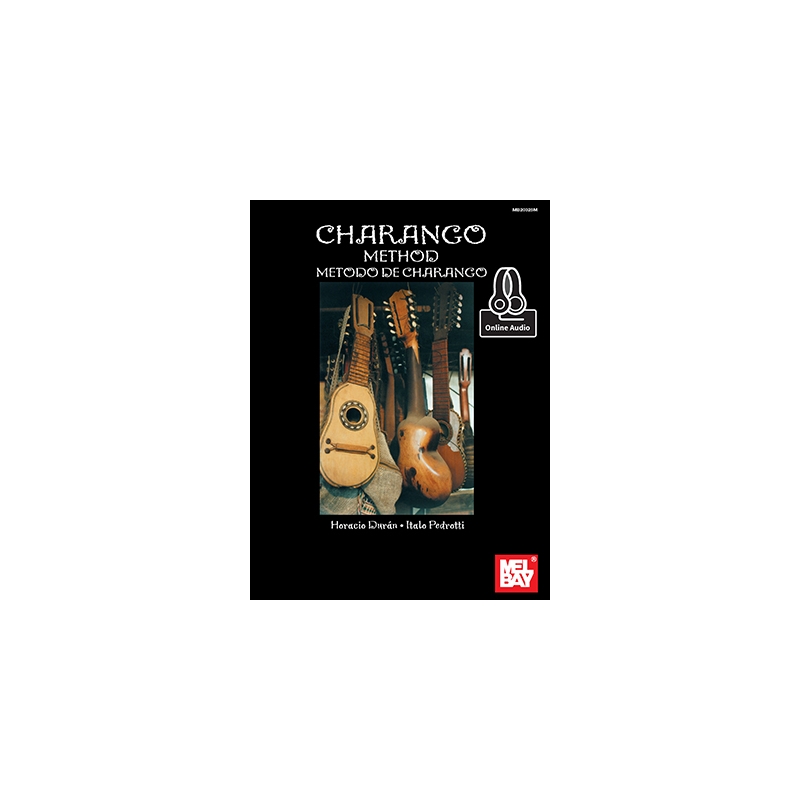This is the first Charango method to use conventional musical notation, and the only bilingual (Spanish and English) text of its kind. These characteristics make the method attractive to musicians with a wide variety of cultural backgrounds, interests and skill levels.
The method is comprised of two parts: A first section regarding strumming techniques and a second section regarding melodic plucking techniques. The first section provides a clear and precise method for learning the "rasgueo" "repique" and "tremolo" skills central to the Charango repertoire. The second section, meanwhile, provides an indispensable guide to expressive techniques for embellishing melodic lines including hammer-ons and pull-offs, trills, simultaneous melodies and arpeggios.
The method is appropriate for a wide range of musical skill levels, from beginners to accomplished Charanguists who want to improve their technical chops. Exercises are clear and progressive. In the event that the student is not familiar with music theory, an appendix clarifies the basics of musical notation. In addition to 201 written exercises for the Charango solo, the method includes 23 South American folk music classics arranged for Charango and guitar accompaniment. It thus serves as both a pedagogical tool and a source of performance repertoire. The musical scores included in the method are accompanied by a free audio download of exercises as well as repertoire played by recognized Chilean Instrumentalists.
CONTENTS
- Presentacion/Presentation
- Acerca del origen del charango Regarding the Charango?s origin
- Charango ind¡gena y charango mestizo The indigenous charango and the mestizo charango
- Dispersi¢n del charango Dispersion of the charango
- Acerca de este m‚todo Regarding this method
- Caracteristicas del charango/Characteristics of the charango
- Afinaci¢n Tuning
- Ambirtos sonoros Sound Production
- El musico y el instrumento/The musician and instrument
- Conceptos escenciales Essential concepts
- Como sostener el charango How to hold the charango
- Rasgueo y pulsaci¢n de las cuerdas Strumming and plucking the strings
- Acerca de las u¤as Regarding nails
- Los acordes en el charango/The chords of the charango
- Capitulo 1: Ritmos y rasgueos/Rhythms and strumming patterns
- 1.1 El huayno
- Ejercicios Exercises 1 - 13
- 1.2 El bailecito
- Ejercicios Exercises 14 - 24
- 1.3 La cueca
- Ejercicios Exercises 25 - 39
- Capitulo 2: El charango como instrumento melodico/The charango as a melodic instrument
- 2.1 Ejercicios iniciales con las cuerdas al aire Preliminary exercises on open stringsÿ
- Ejercicios Exercises 40 - 42
- 2.2 Arpegios Arpeggios
- Ejercicios Exercises 43 - 53
- 2.3 Escalas y melodias Scales and melodies
- Ejercicios Exercises 54 - 69
- 2.4 Melod¡as simult neas Simultaneous melodies
- Ejercicios Exercises 70 - 79
- 2.5 Tremolo arpegiado Arpeggiated tremolo
- Ejercicios Exercises 80 - 86
- 2.6 Recursos mel¢dicos Melodic techniques
- 2.6.1 Ligados entre notas distintas Pull-offs and Hammer-ons
- Ejercicios Exercises 87 - 91
- 2.6.2 Trino Trill
- Ejercicios Exercises 92 - 95
- 2.6.3 Adornos Ornaments
- Ejercicios Exercises 96 - 107
- 2.7 Arm¢nicos Harmonics
- 2.7.1 Arménicos que se obtienen sin pisar las cuerdas Obtaining harmonics on the open strings
- Ejercicios Exercises 108 al 109
- 2.7.2 Arm¢nicos que se obtienen pisando las cuerdas Obtaining harmonics on the fretboard
- Ejercicios Exercises 110 al 113
- Capitulo 3: Tremolo Rasguedo/The strummed tremolo
- Ejercicios Exercises 114 - 118
- Capitulo 4: Repiques
- Ejercicios Exercises 119 - 121
- 4.1 Repiques en compases de 2/4 Repiques in 2/4
- Ejercicios Exercises 122 - 135
- 4.2 Repiques en compases de 3/4 Repiques in 3/4
- Ejercicios Exercises 136 - 153
- 4.3 Repiques en compases de 6/8 Repiques in 6/8
- Capitulo 5 : Otros Patrones Ritmicos/Additional rhythmic patterns
- Ejercicios Exercises 154 - 166
- 5.1 Patrones r¡tmicos en 2/4 Rhythmic patterns in 2/4
- Ejercicios Exercises 167 - 186
- 5.2 Patrones rítmicos en 6/8 y 3/4 Rhythmic patterns in 6/8 and 3/4
- Ejercicios Exercises 187 - 201
- Capitulo 6: Repertorio/ Repertory
- Camino a Potos¡, Freddy Torrealba
- Camino Viejo, Italo Pedrotti
- Campanitas, Alfredo Dom¡nguez
- Cavuriadas, Italo Pedrotti
- De Ushuaia a La Quiaca, Gustavo Santaolalla
- Don Esteban, Horacio Dur n
- Escarcha y Sol, Horacio Dur n
- Estudio para Charango, Mauro Nu¤ez
- Khespi¤a, H‚ctor Soto
- Los Alaracos, Ernesto Cavour
- Manzanitas, Horacio Dur n
- Mis Llamitas, Ernesto Cavour
- Ojito de Agua, Adri n Ot rola
- Oto¤al, Italo Pedrotti
- Punteado, Ernesto Cavour
- Reencuentro, Claudio Araya
- Rosita de Pica, H‚ctor Soto
- Subida, Ernesto Cavour
- Tonada Triste, Horacio Dur n
- Ventolera, Hugo Lagos - Eduardo Carrasco
- Volver s,William Centellas
- Vuelo de P jaros, Italo Pedrotti
- Vuelo de Parinas, C‚sar Palacios



